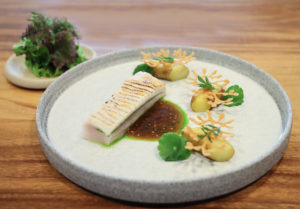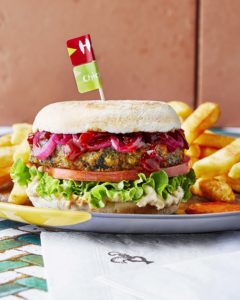We already know that the food industry is a major contributor to climate change. It accounts for over a quarter* of global greenhouse gas emissions (26%), half of the world’s habitable land* is used for agriculture, 78% of global ocean and freshwater pollution* is caused by agriculture, yada yada yada. TBH we’re sick and tired of hearing these stats on repeat. At this point, they’re boring.
Instead of droning on about the doom-and-gloom, let’s focus on action. From eating local and seasonal produce to switching to plant-based alternatives, there’s a myriad of ways in which we can make an impact with how we eat. What we choose, where it comes from, how it was grown, and how it landed on our plate all play an important role. If you eat food, you’re part of the system, and your actions have an impact.
Now, it might seem daunting at times to eat “sustainably”. You might think it means eating tasteless steamed veggies or something along those lines. And we don’t know about you, but we’re major foodies here at GITNB. Yes, we want to make better food choices, but we also want our food to taste delicious!
So on that note, we have an exciting development to tell you about. Restaurants, diners, and home-cooks in Singapore: Listen up. Sustainability just got yummier with the #OnePlanetPlate revolution!
What is One Planet Plate?
It’s the new food movement making waves and it’s the talk of the town.
One Planet Plate is a global restaurant campaign by Food Made Good, presented by HSBC, to put sustainability on the menu. It aims to raise awareness about the inherent problems in our food system and make better alternatives popular. It’s a chance for chefs around the world to show how they’re contributing to a better food future, and to encourage home cooks and diners to make better food choices.
“We’re thrilled with the new campaign, and hungry to grow One Planet Plate both locally and globally,” says Heidi Yu Spurrell, CEO of Food Made Good HK. “After the excitement of our 2020 workshops, when we partnered with WWF HK, Hysan and AFN to work with Hong Kong chefs, we’re extending the initiative this year to Singapore. Food systems in cities the world over face the same challenges – and chefs and diners all have a growing appetite for more planet-friendly choices. Calling all chefs: turn your passion into action and share your tastiest, most sustainable dish with us today!”
While it’s awesome when we make better food choices on a personal level, real change happens when it’s a collective effort. And that’s why we’re so excited about this movement. The campaign has officially launched in the UK and Singapore, but restaurants from all over the world can join the movement and submit recipes. The goal is to serve 5 million sustainable meals in 2022.
Singapore has some ambitious plans to make food more sustainable, and One Planet Plate aims to help reach these goals. For example, the ’30 by 30′ aims to produce 30% of the city’s food needs locally (and sustainably) by 2030. With less than 1% of its land area available for growing food, Singapore is turning to vertical and roof farming, and developing a new high-tech agri-food zone. These initiatives are allowing Singapore chefs and home cooks to source more and more locally-grown fish, eggs, and vegetables.

How does it work?
Chefs around the world can submit the recipes of their favourite dishes, which will be featured on the One Planet Plate website. They can then feature the dish on their own menus with a #OnePlanetPlate badge. It’s up to the chef to choose which recipe to submit, as long as it satisfies at least one of One Planet Plate’s sustainability criteria (which we’ll tell you about in just a bit).
The recipes are featured on the One Planet Plate website and Instagram, and eager home cooks can then try them out in their own kitchens. And mind you, we’re not talking about a boring smoothie or veggie stir fry here. This is the real stuff. I mean, with dishes like wild garlic soup with pickled mushrooms, roasted cauliflower salad with turmeric cauliflower sauce, and leek, hazelnuts, and brown butter on the list? Sign us up!
Diners can quickly and easily find participating restaurants that match their budget, favourite cuisine, and location. Outlets serving One Planet Plate dishes range from fast-service eateries like Quick Greens to Michelin-starred restaurants such as Han Li Guang’s Labyrinth and Sebastien Lepinoy’s Les Amis.
Note: You can also reach out to your favourite local joint and nominate them to submit a dish!

Getting down and dirty with the criteria
So how does a dish qualify to be submitted? It has to satisfy at least one of the following sustainability criteria:
#1 Feature more veg
Eating plant-based is maybe the most effective way to lower your climate footprint through food — and it’s great for your health. A study found that transitioning towards a more plant-based diet could reduce food-related greenhouse gas emissions by 29–70% and global mortality by 6–10% by 2050. Meat and dairy production account for 14.1% of global GHG emissions each year. So eating more veggies is a win-win — for our health, and for the planet’s.
For a dish to qualify under this criteria, at least some portion of animal protein in the dish should be replaced with plant-based ingredients.
Star dish: Melissa Helmley’s Spiced Shepherdess Pie

#2: Low carbon footprint
Every ingredient will have its own carbon footprint. This emissions impact can be expressed as kilograms of CO2 equivalents per kilogram of the ingredient.
For a dish to qualify under this criteria, it must have less than 1kg of CO2 per dish. This might sound pretty vague to you (it did to us), so let’s understand the real impact here. If every dish each of us ate kept within this limit, it would result in a 40% drop in emissions from dining from Europeans.
Star dish: Nando’s Spiced Chickpea Burger

#3: Waste no food
Approximately one-third of the food produced globally for human consumption goes to waste every year. That is nearly 1.3 billion tonnes of food that is either spoiled or spilt in supply chains or wasted by retailers, restaurants, and consumers. This accounts for about 6% of the world’s greenhouse gas emissions. To put that into context, it’s around three times that of emissions from aviation. Or, if food waste was a country, it would be the world’s third-largest emitter, behind only China and the US. Now that’s a lot.
For a dish to qualify under this criteria, the chef must make the most of every ingredient. They must rethink how food surplus or common by-products are used in the dish.
Star dish: Salted & Hung’s Turbot Dashi Broth

#4: Celebrate local
Not only will your produce be the freshest if you shop locally (make sure it’s in season), but it also usually comes with a lower carbon price tag. Think about it — if the produce doesn’t have to be shipped from some faraway location, the GHG emissions associated with transporting it automatically drop.
Shopping locally also helps the local economy thrive and supports small farmers. There’s a growing desire amongst diners to know where their food came from, and local produce helps give them that traceability that they crave.
For a dish to qualify under this criteria, the primary ingredients must be locally sourced, seasonal, and farmed non-intensively.
Star dish: Open Farm Community’s Roasted Eggplant with Wild Herbs

#5: Source seafood sustainably
According to the UNFAO, a third of all fish stocks are being fished unsustainably. But, there is hope. For example, there was a recent resurgence of the North Sea cod due to controlled fishing and quotas. Think beyond the ‘Big 5’: Cod, haddock, tuna, salmon, and prawns.
For a dish to qualify under this criteria, it can only feature seafood species rated ‘1’ or ‘2’ in the Marine Conservations Society’s Good Fish Guide. Additionally, the supply chain must be traceable and transparent for diners.
Star dish: The Mira’s White Radish & Saffron Soup with braised Local Clams

What’s in it for the restaurants?
Well, who doesn’t want to be one of the OGs of a major worldwide movement? All the cool kids are joining. Top restaurants and chefs from around the world have joined the movement, including celebrity chef Raymond Blanc, Terra Madre (see video below), Salted & Hung, and Open Farm Community. There are currently over 2000 restaurants serving #OnePlanetPlate sustainable dishes. Restaurants and chefs will have the chance to share their work on a global platform. And if they’re looking to switch to a more sustainable image, what better than being showcased on a credible sustainable food platform? Additionally, as a sponsor of the campaign, HSBC will share the restaurants on its platforms as well.
Note: It’s free for restaurants to join and submit their planet-friendly recipes.
Making waves on social media
Is there any other way in this day and age? Check out the #OnePlanetPlate hashtag on Instagram if you’re in the mood to look at some truly mouthwatering food porn.
View this post on Instagram
Action through appetite
So, how can you join the movement?
> If you’re a restaurant: Submit a sustainably made dish on One Planet Plate’s website.
> If you’re a diner: Browse through nearby restaurants on One Planet Plate for dishes that look extra yummy. For your next meal out, try one of them out.
> If you’re a home-cook: Scroll through the yummy, sustainable recipes from all over the world and try them out in your own kitchens.
> Everyone: Don’t forget to post your planet-friendly dish on Instagram with the hashtag #OnePlanetPlate!
So what are you waiting for? Vote with your forks, and more importantly — enjoy a yummy meal while you’re at it.
This article was written in collaboration with Food Made Good.
Image: via Food Made Good | Image Description: Chef Gayatri Singh of Terra Madre chopping a cauliflower
*Statistics sources: science.org and ourworldindata.org
